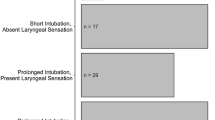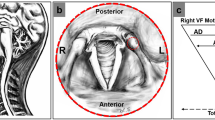Abstract
The laryngeal adductor reflex (LAR) is an airway protective reflex that manifests as a brief vocal fold closure in response to laryngeal stimulation. This study examined if the absence of the LAR in response to touch delivered by a laryngoscope is associated with penetration/aspiration or pneumonia in patients with dysphagia. Inpatients at a teaching hospital with clinical symptoms of dysphagia were recruited upon referral to the otolaryngology clinic for a swallowing evaluation. Otolaryngologists observed the status of secretions and touched each arytenoid with the tip of the laryngoscope. The patients were then asked to swallow 3–5 mL grape gelatin and 3–5 mL colored water. All procedures were video-recorded. Two independent raters noted absence/presence of the LAR and penetration/aspiration of pharyngeal secretions, gelatin, and water on the recorded videos. A diagnosis of pneumonia during the patient’s entire hospital stay was determined by a review of the hospital’s medical records. Statistical analyses were performed using Fisher’s exact test. Sixty-one patients were included. Twenty-one patients (34.5%) did not exhibit the LAR. No association was found between the absent LAR and penetration or aspiration. There was, however, a significant association between an absence of the LAR and pneumonia development. Patients with an absent LAR had 6.8 times the odds of developing pneumonia as compared to those with a present LAR (OR 6.75; 95% CI 1.76–25.96; p < 0.01). Using the LAR as a marker of laryngeal sensory function appears to be valuable for identifying patients at high risk of pneumonia.
Similar content being viewed by others
References
Andreatta RD, Mann EA, Poletto CJ, Ludlow CL. Mucosal afferents mediate laryngeal adductor responses in the cat. J Appl Physiol. 2002;93(5):1622–9.
Dua K, Surapaneni SN, Kuribayashi S, Hafeezullah M, Shaker R. Protective role of aerodigestive reflexes against aspiration: study on subjects with impaired and preserved reflexes. Gastroenterology. 2011;140(7):1927–33.
Shingai T, Shimada K. Reflex swallowing elicited by water and chemical substances applied in the oral cavity, pharynx, and larynx of the rabbit. Jpn J Physiol. 1976;26(5):455–69.
Shock LA, Gallemore BC, Hinkel CJ, et al. Improving the utility of laryngeal adductor reflex testing: a translational tale of mice and men. Otolaryngol Head Neck Surg. 2015;153(1):94–101.
Sun QJ, Chum JM, Bautista TG, Pilowsky PM, Berkowitz RG. Neuronal mechanisms underlying the laryngeal adductor reflex. Ann Otol Rhinol Laryngol. 2011;120(11):755–60.
Onofri SM, Cola PC, Berti LC, da Silva RG, Dantas RO. Correlation between laryngeal sensitivity and penetration/aspiration after stroke. Dysphagia. 2014;29(2):256–61.
Sato S, Fujishima I, Setsu K, Katagiri N, Inao R, Mizuma M. Evaluation for dysphagia by testing laryngeal sensation with a flexible laryngoscope. Jpn J Dysphagia Rehabil. 2002;6(4):44–52.
Murray J, Langmore SE, Ginsberg S, Dostie A. The significance of accumulated oropharyngeal secretions and swallowing frequency in predicting aspiration. Dysphagia. 1996;11(2):99–103.
Donzelli J, Brady S, Wesling M, Craney M. Predictive value of accumulated oropharyngeal secretions for aspiration during video nasal endoscopic evaluation of the swallow. Ann Otol Rhinol Laryngol. 2003;112(5):469–75.
Warnecke T, Ritter MA, Kroger B, et al. Fiberoptic endoscopic dysphagia severity scale predicts outcome after acute stroke. Cerebrovasc Dis. 2009;28(3):283–9.
Langmore S, Kenneth S, Olsen N. Fiberoptic endoscopic examination of swallowing safety: a new procedure. Dysphagia. 1988;2(4):216–9.
Leow LP, Beckert L, Anderson T, Huckabee ML. Changes in chemosensitivity and mechanosensitivity in aging and parkinson’s disease. Dysphagia. 2012;27(1):106–14.
Domer AS, Kuhn MA, Belafsky PC. Neurophysiology and clinical implications of the laryngeal adductor reflex. Curr Otorhinolaryngol Rep. 2013;1(3):178–82.
Clayton NA, Carnaby GD, Peters MJ, Ing AJ. Impaired laryngopharyngeal sensitivity in patients with COPD: the association with swallow function. Int J Speech Lang Pathol. 2014;16(6):615–23.
Kaneoka A, Pisegna JM, Krisciunas GP, Nito T, Stepp CE, LaValley MP, Langmore SE. Variability of the pressure measurements exerted by the tip of laryngoscope during laryngeal sensory testing: a clinical demonstration. AJSLP. 2017;26(3):729–36.
Aviv JE, Martin JH, Keen MS, Debell M, Blitzer A. Air pulse quantification of supraglottic and pharyngeal sensation: a new technique. Ann Otol Rhinol Laryngol. 1993;102(10):777–80.
Teasdale G, Jennett B. Assessment of coma and impaired consciousness. A practical scale. Lancet. 1974;2(7872):81–4.
Teasdale G, Maas A, Lecky F, Manley G, Stocchetti N, Murray G. The glasgow coma scale at 40 years: standing the test of time. Lancet Neurol. 2014;13(8):844–54.
Leder SB, Suiter DM, Duffey D, Judson BL. Vocal fold immobility and aspiration status: a direct replication study. Dysphagia. 2012;27(2):265–70.
Cichero JA, Steele C, Duivestein J, et al. The need for international terminology and definitions for texture-modified foods and thickened liquids used in dysphagia management: foundations of a global initiative. Curr Phys Med Rehabil Rep. 2013;1:280–91.
Rosenbek JC, Robbins JA, Roecker EB, Coyle JL, Wood JL. A penetration-aspiration scale. Dysphagia. 1996;11(2):93–8.
Aviv JE, Murry T, Zschommler A, Cohen M, Gartner C. Flexible endoscopic evaluation of swallowing with sensory testing: patient characteristics and analysis of safety in 1,340 consecutive examinations. Ann Otol Rhinol Laryngol. 2005;114(3):173–6.
Ku PK, Vlantis AC, Leung SF, et al. Laryngopharyngeal sensory deficits and impaired pharyngeal motor function predict aspiration in patients irradiated for nasopharyngeal carcinoma. Laryngoscope. 2010;120(2):223–8.
Hammer GP, Tomazic PV, Vasicek S, et al. Carotid endarterectomy significantly improves postoperative laryngeal sensitivity. J Vasc Surg. 2016;64(5):1303–10.
Phua SY, McGarvey LP, Ngu MC, Ing AJ. Patients with gastro-oesophageal reflux disease and cough have impaired laryngopharyngeal mechanosensitivity. Thorax. 2005;60(6):488–91.
Amin MR, Harris D, Cassel SG, Grimes E, Heiman-Patterson T. Sensory testing in the assessment of laryngeal sensation in patients with amyotrophic lateral sclerosis. Ann Otol Rhinol Laryngol. 2006;115(7):528–34.
Hammer MJ, Murphy CA, Abrams TM. Airway somatosensory deficits and dysphagia in parkinson’s disease. J Parkinsons Dis. 2013;3(1):39–44.
Langmore SE, Skarupski KA, Park PS, Fries BE. Predictors of aspiration pneumonia in nursing home residents. Dysphagia. 2002;17(4):298–307.
Langmore SE, Terpenning MS, Schork A, et al. Predictors of aspiration pneumonia: how important is dysphagia? Dysphagia. 1998;13(2):69–81.
Mor A, Thomsen RW, Ulrichsen SP, Sorensen HT. Chronic heart failure and risk of hospitalization with pneumonia: a population-based study. Eur J Intern Med. 2013;24(4):349–53.
Zhu J, Zhang X, Shi G, Yi K, Tan X. Atrial fibrillation is an independent risk factor for hospital-acquired pneumonia. PLoS ONE. 2015;10(7):e0131782.
Johnson PE, Belafsky PC, Postma GN. Topical nasal anesthesia and laryngopharyngeal sensory testing: a prospective, double-blind crossover study. Ann Otol Rhinol Laryngol. 2003;112(1):14–6.
Kamarunas EE, McCullough GH, Guidry TJ, Mennemeier M, Schluterman K. Effects of topical nasal anesthetic on fiberoptic endoscopic examination of swallowing with sensory testing (FEESST). Dysphagia. 2014;29(1):33–43.
Butler SG, Stuart A, Case LD, Rees C, Vitolins M, Kritchevsky SB. Effects of liquid type, delivery method, and bolus volume on penetration-aspiration scores in healthy older adults during flexible endoscopic evaluation of swallowing. Ann Otol Rhinol Laryngol. 2011;120(5):288–95.
Baijens LW, Speyer R, Pilz W, Roodenburg N. FEES protocol derived estimates of sensitivity: aspiration in dysphagic patients. Dysphagia. 2014;29(5):583–90.
Centers for disease control and prevention/National Healthcare Safety Network (CDC/NHSN) [Internet]. CDC/NHSN surveillance definitions for specific types of infections (2014) http://www.cdc.gov/nhsn/PDFs/pscManual/17pscNosInfDef_current.pdf33. Accessed 29 Sept 2016
Acknowledgements
The authors thank Mr. Yasunori Kumono and Mr. Masato Takahashi for their support in technical issues.
Funding
No funding was received for this study.
Author information
Authors and Affiliations
Corresponding author
Ethics declarations
Conflict of interest
The authors declare that they have no conflict of interest.
Rights and permissions
About this article
Cite this article
Kaneoka, A., Pisegna, J.M., Inokuchi, H. et al. Relationship Between Laryngeal Sensory Deficits, Aspiration, and Pneumonia in Patients with Dysphagia. Dysphagia 33, 192–199 (2018). https://doi.org/10.1007/s00455-017-9845-8
Received:
Accepted:
Published:
Issue Date:
DOI: https://doi.org/10.1007/s00455-017-9845-8




